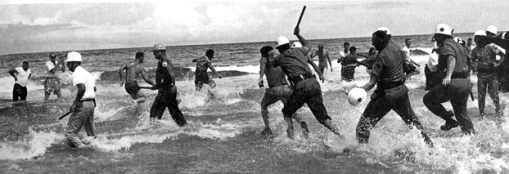By Kartik Krishnaiyer
Martin Luther King Jr. is one of only four Americans honored by a federal holiday. Some states have other Americans or Confederates to honor. For example, in Virginia Abraham Lincoln is not honored by President’s Day, but Robert E. Lee is honored on Washington/Lee Day. Here in Florida, the birthday of Senator Jefferson Davis, who was the President of the Confederacy is an official state holiday.
MLK Jr. day wasn’t universally accepted as a holiday in all states. Most notably among these was Arizona, who lost the right to host a Super Bowl, endured a boycott (which included countless College Football teams turning down a bid to the prestigious Fiesta Bowl), and lost billions of dollars in conventions and tourism thanks to a reluctance to adopt the holiday.
But Florida didn’t hesitate to adopt the MLK holiday. Coming just two decades after the violence in St. Augustine we chronicled yesterday, the shift in attitude towards civil rights and the King legacy in the Sunshine State was stark. The number of African-American political leaders in the state by the mid-eighties speaks for itself. But King’s real impact was among white politicians whose progressive ideas, which were only possible in a post Civil Rights era, moved Florida forward.
The 1970s were an age of enlightenment in Florida. The election of Pensacola’s Reuben Askew in 1970 changed the state forever. Gone were the reactionary deep south tendencies of Florida towards issues of government spending, race and corruption. In it’s place was Askew, a visionary leader who Harvard University ranked as one of the ten best state executives in the 20th century United States.
Askew didn’t have an easy time dealing with a State Senate that was led by the likes of W.D. Childers, Dempsey Barron, and Jerry Thomas. These conservative Democrats that controlled the process didn’t like Askew and his ideas. But the Governor had the people on his side and by taking his case to the voters and circumventing the conservative, backward thinking Senators he won. The Conservatives ran Thomas and Ben Hill Griffin in an effort to destroy Askew in 1974 but he only became stronger.
In the State Senate two Democrats fought against the conservative leadership. For their courage they were blackballed and were labeled “doghouse democrats.” They were Bob Graham from Miami Lakes, and Buddy MacKay from Ocala. Both emerged as statewide leaders thanks to their courage and their strong ideas for moving Florida forward in the 1970s.
In 1970 Lawton Chiles became a US Senator thanks to a bi-racial coalition of voters and over the next twenty eight years Chiles was among the most inspirational and thoughtful figures Florida had ever produced.
Martin Luther King’s legacy obviously extended to African-American leadership in the state. But in Askew, Graham, MacKay and Chiles, the post-MLK world provided Florida the leadership other Sun Belt states lacked to transform Florida from 1970 to 1998 into a bastion of progressive ideas and policies. Alas, with the election of Jeb Bush in 1998 and the backsliding of Florida’s Legislature towards the tendencies of Dempsey Barron, the progress of the 1970s, 80s and early 90s is being squandered.
